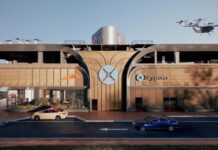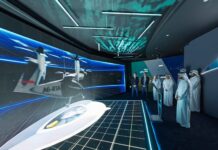By Gerhard Hope www.constructionweekonline.com
The electro-mechanical division of the ETA Ascon Star group was established in 1976 in Deira, with three people. Today it employs 16,000 and has an order book of AED3 billion.
 As an indication of the size of the ETA Ascon Star group, it employs 75,000 people, or 1.5% of the UAE’s total population. The ETA M&E division has won the Top Contractor category at the MEP Awards for three years in a row, and has been at the forefront of Dubai’s most iconic projects, from Burj Khalifa to the Dubai Metro.
As an indication of the size of the ETA Ascon Star group, it employs 75,000 people, or 1.5% of the UAE’s total population. The ETA M&E division has won the Top Contractor category at the MEP Awards for three years in a row, and has been at the forefront of Dubai’s most iconic projects, from Burj Khalifa to the Dubai Metro.
“When we started [the M&E division], it was in a rented apartment in Nasser Square, Deira. In 1976 the market was very small compared to what it is now. Ground plus seven storeys used to be the biggest project, with three to four being standard. At that stage we also focused exclusively on Bur Dubai and Deira,” says Jegabber. “The biggest breakthrough for us in this period was the Etisalat head office in Deira in 1990. This was a landmark building. Prior to that we had been involved with the Ruler’s Court in Bur Dubai in 1985, and from this point on there was no looking back. All the major projects in Dubai have been in ETA’s portfolio,” says Jegabber.
Jegabber has been director of the M&E division for two years, having joined ETA in 1990. He reports to senior executive director A.K. Agarwal. Prior to that he worked in Saudi Arabia with the same group from 1985. The division started with three employees; today it has 2,000 permanent staff in Dubai alone, 9 000 in-house workers and about 5 000 external sub-contracting staff.
“We also have quite a considerable number of staff in Abu Dhabi and Doha,” says Jegabber. “In terms of the larger group, the M&E division, with Dubai and Abu Dhabi combined, comprises one third of the total group. It is the biggest division, with the highest turnover.” Jegabber says the secret to the division’s success is that it offers “a single point solution” that combines the traditional MEP scope of works with more specialised services such as tunnel ventilation for the Dubai Metro.
Experience
“We had already gained experience in this regard with our work on the Delhi Metro. Expertise in tunnel ventilation was a prequalification for the Dubai Metro, which contributed to us landing the contract. This is a safety-critical aspect of the project as it should never fail, irrespective of any failure of the main power supply. It has also been designed as a reverse process in that, in the event of any fire, it changes direction and extracts the smoke,” explains Jegabber.
“When it comes to buildings, we do all sorts of specialist building services as well, especially upgrades. Apart from electro-mechanical works, we also carry out BMS, fire alarm and fire fighting and structured cabling to security services. I would say that, other than civils and elevators, which is another one of our divisions, we carry out complete building activities. A building has three major components, namely civil works, elevators and then electro-mechanical, plus all the specialist services,” says Jegabber.
He adds that ETA has been at the forefront of all major trends in the local construction industry, from being “the first contracting company to be awarded ISO here” to embracing the latest green building trends.
“If a new development comes along, ETA likes to get in there first and ensure it has all the necessary equipment and expertise in place so it is in a prime position to land major projects. We stay ahead, and then other people follow.”
Success
From an average of three to four floors in the Deira days, the M&E division now has 150-storey towers under its belt. Yet Jegabber is careful to qualify this meteoric success: “We are the same company as when we started out, doing the same thing now.
“Many companies came in-between and disappeared in-between. Very few companies started and then developed like we did. I would say we are continuing this trend, and are still number one.”
Jegabber acknowledges that the MEP sector is highly competitive at the moment. “We continue to be competitive; otherwise we would never have been as successful as we are. We are known for our quality and pricing in the sector. We are clinching contracts based purely on our competitive advantage and service offering, not simply due to the size of the group or its presence in the industry. This is the reason we have been so successful.”
Another element of the group’s success lies in the fact “it is corporate policy not to make profit at every level. This means that, in addition to our large service offering, we are also able to offer very competitive rates,” says Jegabber. However, changing market conditions have put some strain on this business model.
“The market here has seen among the highest growth rates in the world. During this peak period, a lot of smaller companies entered the market due to the demand, which had reached point where the existing companies could not meet the requirements. Now the number of jobs has come down, but the number of players has not – and they are competing with us. The level of competition for the limited number of jobs has not changed.
Competitive
“Being competitive is different for small, medium and large companies. Thus bigger companies like ETA are suffering because of the ‘unfair’ competition, which is what the contractors say. On the customer side, they are unable to make payment in a timely due to the financial situation. Projects are dragged out beyond the actual completion dates. A project to which we committed to two years’ ago is still occupying us now.
Due to this, our costs have increased,” says Jegabber. “We need to retain the same staff and workforce to carry on with these contracts. However, the customers can not even meet the financial obligations of the original contracts, let alone the extension claims. And so our profits have come down very much. On the suppliers’ side, in terms of materials especially, there is a lack of confidence in the market.
“So on the one side we are under pressure to pay our contractors and suppliers, while on the other we are not getting the money from the client. This is placing us in a situation that has gone from bad to worse. We are struggling to carry on in this kind of market situation. This is our main challenge at present,” says Jegabber.
The situation is compounded by the fact “there is no inflow of projects like we used to have in order to sustain the market at present. We have one project here and one over there.
Negotiation
“Previously we were able to tell our suppliers not to worry, as we have money coming in from various sources, so can give you another project in the interim. This kind of negotiation is much less possible now due to the current situation,” says Jegabber.
In terms of current projects, ETA has been on-site at Concourse 3 of Dubai International Airport for a year now. It is also gearing up for completion of the Dubai Metro’s Green Line, and is continuing with work at the Burj Khalifa apartments. “Currently we are still number one because of the nature and size of our projects,” says Jegabber.
“Yes, we are seeing evidence of a pick-up,” he responds. “A lot of projects that stalled due to the downturn are picking up again, while current projects stopped at the design stage are now coming back. New projects are also being planned. We are seeing some green shoots.” However, Jegabber says “the market will not return to the same magnitude as before. It will take some time, and will probably never go back to the 2006-2008 level.
But certainly we will be able to say that we are still here. Also, in order to sustain our position in terms of turnover, and to retain our skills and resources, we have extended our operation into Saudi Arabia a few months ago, in addition to our presence in Abu Dhabi and Qatar. We also opened our operation in Oman recently,” concludes Jegabber.



















